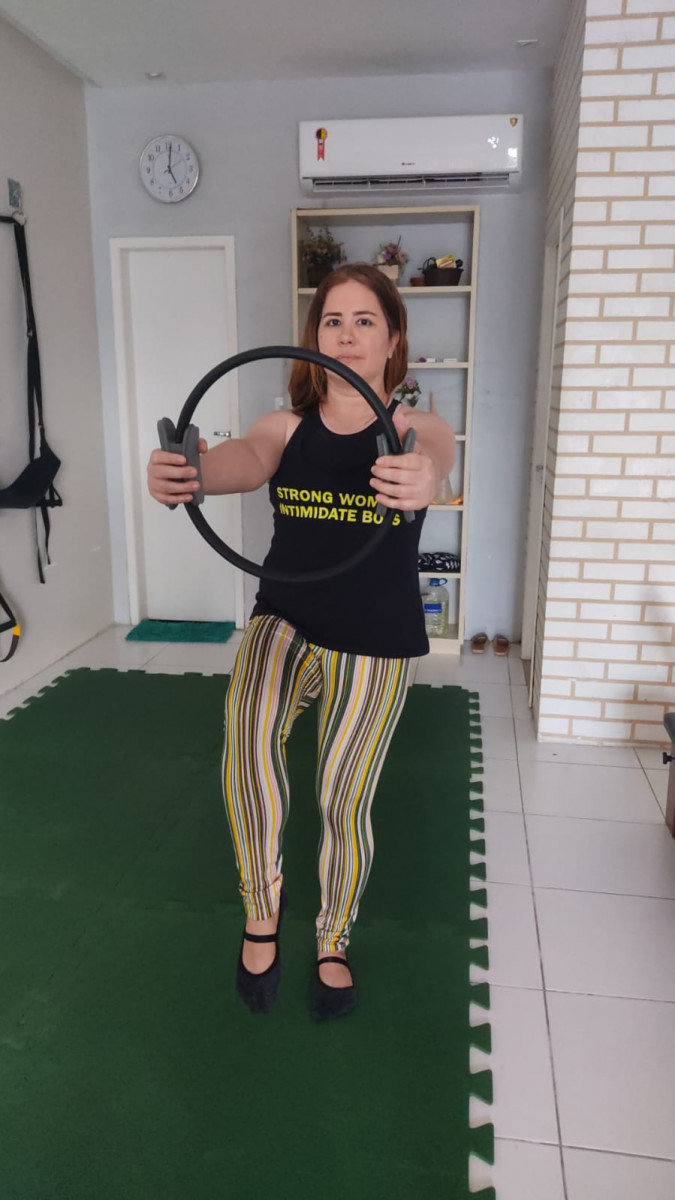Pilates can be broadly categorized into three main types, each emphasizing slightly different approaches and equipment. Here are the three types of Pilates:
- Mat Pilates:
- Description: Mat Pilates is performed on the floor using a mat, and it primarily focuses on body weight resistance and controlled movements.
- Characteristics: Exercises in Mat Pilates target core strength, flexibility, and overall body awareness. It’s a foundational form of Pilates that can be done with minimal equipment.
- Reformer Pilates:
- Description: Reformer Pilates involves the use of a specialized piece of equipment called a reformer. The reformer consists of a sliding carriage, springs, and various attachments for resistance.
- Characteristics: This type of Pilates provides a wider range of resistance and support, allowing for more versatility in exercises. It often involves both upper and lower body movements, enhancing overall strength and flexibility.
- Equipment-Based Pilates:
- Description: Equipment-based Pilates encompasses a variety of specialized apparatus such as the Cadillac, Wunda Chair, and Barrel. Each piece of equipment offers unique challenges and variations in exercises.
- Characteristics: These apparatuses provide additional resistance and support, allowing for a more customized and targeted workout. Equipment-based Pilates can be tailored to individual needs and goals.
While these are the three main types, Pilates is a versatile discipline, and many variations and hybrid approaches exist. Classes and instructors may incorporate elements from each type to create a comprehensive and personalized Pilates experience.
Is it good to do a variety of Pilates exercise ?
Yes, incorporating a variety of Pilates exercises into your routine can be highly beneficial for several reasons:
- Muscle Engagement: Different Pilates exercises target various muscle groups, promoting overall muscular development. A variety of movements ensures that you work on strength, flexibility, and endurance across multiple areas of your body.
- Balanced Development: Pilates emphasizes a holistic approach to fitness, focusing on core strength, flexibility, and posture. A diverse set of exercises helps ensure a balanced and well-rounded development of your body.
- Prevention of Plateaus: Regularly changing your Pilates routine prevents your body from adapting too quickly to specific movements. This helps avoid fitness plateaus and keeps your workouts challenging and effective.
- Mind-Body Connection: Pilates encourages a strong mind-body connection. Introducing variety challenges your coordination and concentration, enhancing your overall awareness during each session.
- Injury Prevention: A diverse range of exercises reduces the risk of overuse injuries by distributing the workload across various muscle groups. It also allows you to modify your routine if you have specific health considerations or physical limitations.
- Personalized Progress: A mix of exercises allows you to tailor your Pilates routine to your individual goals. Whether you’re focusing on core strength, flexibility, or rehabilitation, a varied approach helps address specific needs.
- Enhanced Motivation: Trying new exercises can add an element of excitement to your Pilates practice, keeping you motivated and engaged over the long term.
Remember to listen to your body and gradually introduce new exercises to avoid strain or injury. Consulting with a certified Pilates instructor can help you create a well-balanced and personalized routine that aligns with your fitness goals.
Four Types of Exercise Can Improve Your Health and Physical Ability
Certainly! Four types of exercise that can significantly improve your health and physical ability are:
- Aerobic Exercise (Cardiovascular Exercise):
- Description: Aerobic exercises increase your heart rate and breathing, improving cardiovascular health.
- Benefits: Enhances cardiovascular endurance, burns calories, and improves overall heart health.
- Examples: Running, brisk walking, cycling, swimming, dancing, and aerobics.
- Strength Training (Resistance Exercise):
- Description: Strength training involves resistance to build and tone muscles, promoting strength and endurance.
- Benefits: Increases muscle mass, boosts metabolism, enhances bone density, and supports joint health.
- Examples: Weightlifting, bodyweight exercises, resistance band workouts, and functional strength training.
- Flexibility and Stretching Exercises:
- Description: Flexibility exercises focus on improving the range of motion in your joints and reducing muscle stiffness.
- Benefits: Enhances flexibility, reduces the risk of injury, and promotes better posture and balance.
- Examples: Yoga, Pilates, dynamic stretching, and static stretching.
- Balance and Stability Exercises:
- Description: Balance and stability exercises improve your ability to control and stabilize your body.
- Benefits: Enhances coordination, reduces the risk of falls, and supports functional movements.
- Examples: Tai Chi, balance exercises on one leg, stability ball exercises, and certain yoga poses.
Incorporating a combination of these four types of exercise into your routine provides a well-rounded approach to fitness, targeting various aspects of physical health. Always consult with a healthcare professional or fitness expert before starting a new exercise program, especially if you have any pre-existing health conditions.
Conclusion
In conclusion, integrating a balanced combination of the four types of exercise – aerobic, strength training, flexibility and stretching, and balance and stability exercises – forms a comprehensive approach to improving overall health and physical ability.
Aerobic exercises enhance cardiovascular health, strength training builds muscle and boosts metabolism, flexibility exercises improve joint range of motion and reduce stiffness, and balance and stability exercises enhance coordination and reduce the risk of falls.
Embracing diversity in your exercise routine not only promotes physical well-being but also contributes to a more holistic and sustainable approach to fitness. Remember to tailor your exercise regimen to your individual needs, listen to your body, and seek guidance from fitness professionals to ensure a safe and effective fitness journey. Regular engagement in these varied exercises can lead to improved overall health, increased energy levels, and enhanced physical capabilities.
Discover more from Pilates All Ages
Subscribe to get the latest posts sent to your email.
